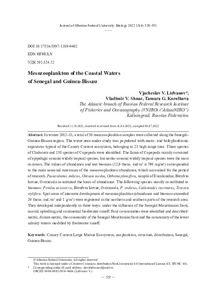Показать сокращенную информацию
Мезозоопланктон прибрежных вод Сенегала и Гвинеи-Бисау
| Автор | Лидванов, В. В. | ru_RU |
| Автор | Шнар, В. Н. | ru_RU |
| Автор | Королькова, Т. Г. | ru_RU |
| Автор | Lidvanov, Vjacheslav V. | en |
| Автор | Shnar, Vladimir V. | en |
| Автор | Korolkova, Tamara G. | en |
| Дата внесения | 2022-12-31T09:26:47Z | |
| Дата, когда ресурс стал доступен | 2022-12-31T09:26:47Z | |
| Дата публикации | 2022-12 | |
| URI (для ссылок/цитирований) | https://elib.sfu-kras.ru/handle/2311/149808 | |
| Аннотация | У прибрежья Сенегала и Гвинеи-Бисау собрано 50 проб мезозоопланктона на съемке, выполненной зимой 2012/13 г. Обнаружены типичные для экосистемы Канарского апвеллинга меро- и голопланктонные организмы, относящиеся к 23 крупным таксонам. Среди Cladocera идентифицированы 3 вида, среди Copepoda – 158 видов. Фауна Copepoda была представлена преимущественно океаническими поверхностными широкотропическими видами, но нерито-океанические широкотропические виды имели наибольшую встречаемость. Численность и биомасса (12,9 тыс. экз./м3 и 790 мг/м3) соответствовали основному сезонному максимуму обилия, который пришелся на период исследований. Основу численности формировали Paracalanus indicus, Oncaea media, Oithona plumifera, науплии представителей сем. Eucalanidae, а также Ostracoda и личинки Bivalvia. Основу биомассы создавали Penilia avirostris, а также личинки Bivalvia, Ostracoda, P. indicus, Calanoides carinatus, Temora stylifera. Очаги интенсивного развития зоопланктона (численность и биомасса превышали 20 тыс. экз./м3 и 1 г/м3) зафиксированы на севере и на юге района, они развивались независимо тремя путями: под влиянием Сенегало-Мавританского фронта (СМФ), прибрежного апвеллинга и материкового стока. Выделено и описано четыре сообщества: сообщество вод СМФ, неритическое и дальненеритическое сообщества, а также сообщество вод, модифицированных материковым стоком | ru_RU |
| Аннотация | In winter 2012–13, a total of 50 mesozooplankton samples were collected along the Senegal–Guinea-Bissau region. The water area under study was populated with mero- and holoplanktonic organisms typical of the Canary Current ecosystem, belonging to 23 high range taxa. Three species of Cladocera and 158 species of Copepoda were identified. The fauna of Copepoda mainly consisted of epipelagic oceanic widely tropical species, but nerito-oceanic widely tropical species were the most common. The values of abundance and wet biomass (12,9 thous. ind/m3 и 790 mg/м3) corresponded to the main seasonal maximum of the mesozooplankton abundance, which accounted for the period of research. Paracalanus indicus, Oncaea media, Oithona plumifera, nauplii of Eucalanidae, Bivalvia larvae, Ostracoda constituted the basis of abundance. The following species mostly contributed to biomass: Penilia avirostris, Bivalvia larvae, Ostracoda, P. indicus, Calanoides carinatus, Temora stylifera. Spot areas of intensive development of mesozooplankton (abundance and biomass exceeded 20 thous. ind./m3 and 1 g/m3) were registered in the northern and southern parts of the research area. They developed independently in three ways: under the influence of the Senegal-Mauritanian front, coastal upwelling and continental freshwater runoff. Four communities were identified and described: neritic, distant-neritic, the community of the Senegal-Mauritanian front and the community of the lower salinity waters modified by freshwater runoff | en |
| Язык | ru | ru_RU |
| Издатель | Сибирский федеральный университет. Siberian Federal University | en |
| Тема | экосистема Канарского апвеллинга | ru_RU |
| Тема | зоопланктон | ru_RU |
| Тема | структура | ru_RU |
| Тема | распределение | ru_RU |
| Тема | Сенегал | ru_RU |
| Тема | Гвинея-Бисау | ru_RU |
| Тема | Canary Current Large Marine Ecosystem | en |
| Тема | zooplankton | en |
| Тема | structure | en |
| Тема | distribution | en |
| Тема | Senegal | en |
| Тема | Guinea-Bissau | en |
| Название | Мезозоопланктон прибрежных вод Сенегала и Гвинеи-Бисау | ru_RU |
| Альтернативное название | Mesozooplankton of the Coastal Waters of Senegal and Guinea-Bissau | en |
| Тип | Journal Article | ru_RU |
| Контакты автора | Лидванов, В. В.: Атлантический филиал федерального государственного бюджетного научного учреждения «Всероссийский научно-исследовательский институт рыбного хозяйства и океанографии» Российская Федерация, Калининград | ru_RU |
| Контакты автора | Шнар, В. Н.: Атлантический филиал федерального государственного бюджетного научного учреждения «Всероссийский научно-исследовательский институт рыбного хозяйства и океанографии» Российская Федерация, Калининград | ru_RU |
| Контакты автора | Королькова, Т. Г.: Атлантический филиал федерального государственного бюджетного научного учреждения «Всероссийский научно-исследовательский институт рыбного хозяйства и океанографии» Российская Федерация, Калининград | ru_RU |
| Контакты автора | Lidvanov, Vjacheslav V.: The Atlantic branch of Russian Federal Research Institute of Fisheries and Oceanography (VNIRO) (“AtlantNIRO”) Kaliningrad, Russian Federation; slavalidvanov@mail.ru; ORCID: 0000-0002-5014-4606 | en |
| Контакты автора | Shnar, Vladimir V.: The Atlantic branch of Russian Federal Research Institute of Fisheries and Oceanography (VNIRO) (“AtlantNIRO”) Kaliningrad, Russian Federation | en |
| Контакты автора | Korolkova, Tamara G.: The Atlantic branch of Russian Federal Research Institute of Fisheries and Oceanography (VNIRO) (“AtlantNIRO”) Kaliningrad, Russian Federation | en |
| Страницы | 529–551 | ru_RU |
| DOI | 10.17516/1997-1389-0402 | |
| Журнал | Журнал Сибирского федерального университета.Биология. Journal of Siberian Federal University.Biology, 2022 15 (4) | en |

